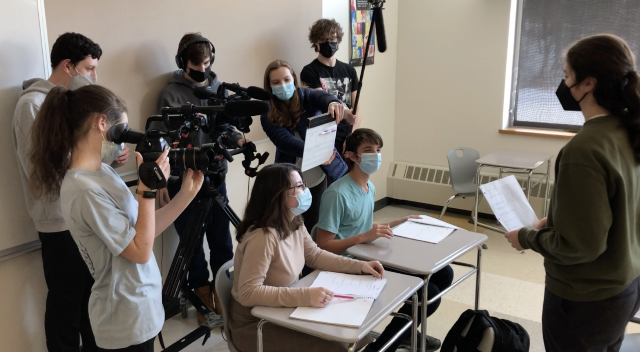Honors Script to Screen holds its 10th annual Movie Festival
Credit: Jim Mullane
Sophomore actors Wilson Harding and Bethany Foreman along with senior actor Vic Macaluso practice their lines while the camera crew prepares to shoot a scene for “The Curse of the Minds of the Students of the Morrigan From Hell.” The film was a project from Wayland High School’s Honors Script to Screen class.
June 17, 2022
On June 13, 2022, the Honors Script to Screen class held its 10th annual Movie Festival. In this class, students have the opportunity to direct their movies, indulge in their imagination and bring their vision to life. After a year of hard work and dedication, sophomore directors Brendan Hines and Sam Conners are ready to present their film: “The Curse of the Minds of the Students of the Morrigan From Hell.”
In this homage to a 1950s horror/sci-fi movie, three students find themselves in a monster attack at school. Together, they must put an end to this demon’s uprising before any more danger prevails.
Hines and Conners decided on a horror film due to the appeal of the genre’s versatility. The two were most excited to add in special effects, such as filming in black and white and using a green screen. Hines emphasized that it was key for the plot to remain central to the film while also leaving flexibility in the storyline for his actors to bring their creativity and artistry.
“I think what makes my movie special is my monster, the Morrigan,” Hines said. “Because, [even though] there have been tons of monster movies and even monsters similar to mine, it’s special because I’m taking my dog Winston, shooting green screen footage of his head, and put it onto one of my actor’s bodies and it’ll be like a dog, man, human thing.”
These collective aspects of the movie intrigued senior Asher Biddle to audition as an actor for the film, where he eventually got the part of Morrigan. As one of the main roles of being the monster, Biddle felt challenged connecting with this difficult character.
“Obviously, I don’t have that much experience as a demon that has been summoned from hell,” Biddle said. “So, I found a way to connect with that one through the physicality of it.”
Biddle leaned into this strategy, unafraid to exaggerate his body movement through his arms and legs to get into character.
The crew also experienced some challenges along the way with the pressure of upcoming deadlines. Hines and Conners began writing the script in September and finished by December. Then they filmed until April. They made final revisions on June 13, the very day of the film festival.
Hines noted that there were multiple scheduling conflicts, resulting in unexpected delays that took days and sometimes weeks to make up.
“A big problem we ran into is the actors’ schedules because everyone has so many different things going on, so many different things to do, and we had to adjust to that,” Hines said.
Biddle seconds this opinion.
“You only have about 40-50 minutes during class after you factor in how much time it takes to set up,” Biddle said. “It was really challenging, especially towards the end where there’s starting to be more of a time crunch.”
Directing a movie sounds simple and even easy at first glance since the camera rolls, the directors call action and the performers give their lines. However, the entire process is not that simple. There is a great deal of work that goes on behind the camera, just as much as in front. In particular, Conners found the scrupulous attention to detail in editing to be surprising.
“I’d say [editing] is a big part of the film,” Conners said. “It seems easy, but it’s not. You have to trim the clips to be exactly what you want, and some cuts can seem too quick.”
Communication is critical in the process of filmmaking. Directors must convey their ideas to their cast with clarity. Instilling a sense of leadership but also collaborating as a team. Honors Script to Screen teacher Jim Mullane gave some guidance to his students and helped them through their journey.
“A good director listens and doesn’t squash someone’s idea,” Mullane said. “They let [the actors] try their idea, and then take it and merge it with theirs.”
Mullane goes on to describe how it is important to recognize when to put aside your pride and open up to other people’s suggestions.
“This is the important part of directing, their idea might be better than yours, and you have to be smart enough to realize that,” Mullane said. “When I used to direct, I always tried to listen to the actors and get what they wanted to put into this performance and then put in my ideas, but [they] have to prove why this should be this way.”





![Last Wednesday, the Wayland School Committee gathered to discuss a number of topics regarding the health curriculum and Innovation Career Pathway course. Another large topic of conversation was the ways to potentially mitigate distracting cell phone usage. "These [phones] are going to distract your learning and social relationships," Superintendent David Fleishman said. "That's concrete right there."](https://waylandstudentpress.com/wp-content/uploads/2025/06/Screenshot-2025-06-04-at-9.49.31 PM-1200x886.png)



























![Troy Hoyt finishes the Boston Marathon, running for the Hoyt Foundation. T. Hoyt is the son of Hoyt Foundation CEO Russ Hoyt.
“[Running a marathon] might seem like a big thing, when it’s presented to you at first, but if you break it up and just keep telling yourself, “Yes, you can,” you can start chipping away at it. And before you know it, you’ll be running the whole 26 miles, and you won’t even think twice about it.” T. Hoyt said.](https://waylandstudentpress.com/wp-content/uploads/2025/04/C36E8761-1CBB-452E-9DF2-543EF7B1095E_1_105_c.jpeg)












































